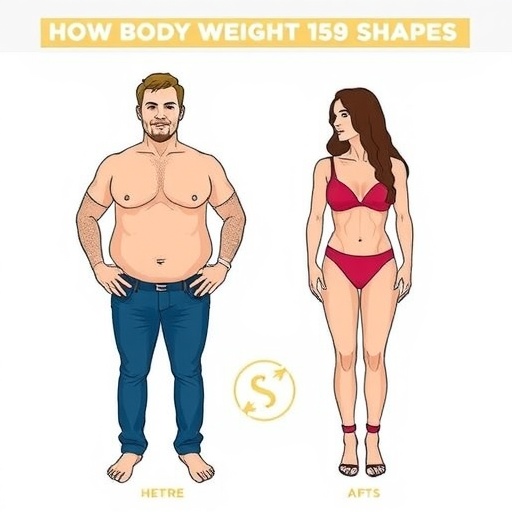In contemporary Western societies, the cultural valorization of slimness has become deeply entrenched, profoundly shaping social attitudes and personal identities. Despite this, the prevalence of overweight and obesity continues to rise at a staggering pace, posing significant public health challenges worldwide. This paradox between societal ideals and actual demographic trends creates a fertile ground for complexities in interpersonal interactions. A pervasive byproduct of this context is weight discrimination, a form of bias where individuals living with overweight experience prejudgment and marginalization, often based on superficial physical attributes rather than their intrinsic qualities. Yet, the psychological mechanisms through which body weight becomes salient in the process of forming first impressions have remained largely unexplored until now.
In a groundbreaking study recently published in the International Journal of Obesity, researchers de Chanaleilles, Cheval, Dubouchaud, and colleagues delve deeply into the cognitive salience of body weight during impression formation. Their investigation sheds new light on how the attribute of overweight influences the evaluative processes individuals undergo when meeting someone for the first time. This novel research addresses a critical gap in social cognition literature by systematically examining how and to what extent body weight constitutes a focal dimension in the initial appraisal of others, thereby influencing subsequent interpersonal dynamics.
To contextualize their inquiry, the authors underscore the social construct of slimness as a hegemonic ideal in Western cultures, where thinness is often equated with discipline, attractiveness, and success. Contrarily, overweight and obesity are stigmatized, frequently associated with negative stereotypes, such as laziness or lack of self-control. These cultural narratives not only affect societal attitudes but also infiltrate everyday social encounters, shaping the lens through which individuals perceive and evaluate others. The research team hypothesized that body weight stands as a salient, and sometimes overriding, attribute shaping first impressions, independent of other evaluative criteria.
Methodologically, the study employed a robust experimental design involving diverse participant cohorts exposed to controlled visual and textual stimuli portraying individuals with varying body weights. By assessing spontaneous and reflective judgments, the researchers quantified the relative prominence of body weight as an attribute influencing impression formation. Their analytical framework integrated psychometric assessments, implicit association measures, and multidimensional scaling techniques to capture the nuanced interplay between body weight and impression salience. Such a multifaceted approach ensured comprehensive insights into the psychological processes at play.
The findings revealed that overweight is indeed a highly salient characteristic in the impression formation process, often eclipsing other traits such as competence, warmth, and trustworthiness. This salience operates at both conscious and subconscious levels, suggesting that body weight functions as a heuristic or shortcut in social perception. Participants consistently demonstrated quicker and stronger associations between overweight portrayals and negative evaluative dimensions, highlighting the automaticity of weight-related biases. These results underscore how deeply ingrained societal stereotypes become embedded in cognitive schemas governing social judgments.
Moreover, the research highlighted the contextual variability of weight salience. For example, first impressions formed in professional or achievement-oriented settings tended to emphasize body weight more prominently as a determinant of perceived competence. Conversely, in social or affiliative contexts, overweight was more strongly linked to judgments of warmth and likability, often unfavorably. This contextual modulation suggests that body weight interacts dynamically with situational cues to shape impression hierarchies, further complicating the social reality faced by individuals with overweight.
Importantly, the study elucidated mechanisms underpinning weight discrimination by demonstrating that the salience of body weight can lead to biased decision-making and social exclusion right from the outset of interpersonal interactions. When body weight is perceived as a defining attribute, it narrows the scope of social evaluation, relegating other substantive characteristics to the background. This cognitive narrowing effect provides a psychological explanation for pervasive discriminatory behaviors, such as dismissive attitudes or exclusion in social and occupational domains, and highlights the urgent need for interventions targeting implicit biases.
The implications of these findings extend beyond academic discourse, carrying significant weight for public health, policy-making, and societal efforts to foster inclusivity. By clarifying how body weight shapes first impressions, the study offers a crucial empirical foundation to design interventions aimed at mitigating weight-based stigma. Educational campaigns, bias reduction training, and the promotion of more diverse body representations in media are among potential strategies informed by this research to combat the detrimental impact of weight salience on social equity.
Furthermore, the authors stress the importance of longitudinal investigations to understand the long-term effects of weight salience on relationship development and psychosocial well-being. While this study focuses on initial impressions, subsequent interpersonal experiences could either reinforce or attenuate these early weight-based biases. Exploring these trajectories could provide critical insights into resilience mechanisms and inform therapeutic approaches for individuals navigating stigma-related stress.
The study also calls attention to the intersectionality of weight stigma with other social identities such as gender, ethnicity, and age. Future research avenues may probe how the salience of body weight interacts with these factors to produce complex layers of bias and discrimination. Understanding these intersections is vital for crafting tailored interventions that address the multifactorial nature of social marginalization.
In methodological terms, the integration of advanced neurocognitive measures could further elucidate the neural correlates of weight salience in impression formation. Functional neuroimaging studies might uncover brain regions implicated in processing overweight attributes and their connections to affective and evaluative networks. Such neurobiological insights could pave the way for novel intervention points, potentially involving cognitive retraining or neuromodulatory techniques.
In sum, this pioneering research significantly advances our comprehension of the cognitive salience of body weight within social perception. It establishes that overweight is not merely a superficial physical characteristic but a potent social marker that influences first impressions with profound ramifications. The study challenges societies to critically reflect on entrenched biases and calls for a collective commitment to fostering social environments that value individuals beyond corporeal appearances.
The study by de Chanaleilles and colleagues represents a critical step toward dismantling the insidious weight stigma that undermines social justice and human dignity. It invites us to question how societal norms shape our unconscious judgments and to envision a future where respect and equity transcend bodily differences.
Subject of Research: The salience of body weight in shaping first impressions and its role in weight discrimination within social cognition.
Article Title: The weight of weight: the salience of body weight in the impression formation process.
Article References:
de Chanaleilles, M., Cheval, B., Dubouchaud, H. et al. The weight of weight: the salience of body weight in the impression formation process. Int J Obes (2025). https://doi.org/10.1038/s41366-025-01921-3
Image Credits: AI Generated
DOI: https://doi.org/10.1038/s41366-025-01921-3
Tags: biases in social cognitionbody weight and first impressionscognitive salience of body weightcomplexities of social perceptioncultural ideals of slimnessimplications of body image on identityinterpersonal interactions and weightpsychological impact of body weightpublic health challenges of obesityresearch on impression formationsocial attitudes towards obesityweight discrimination and bias





